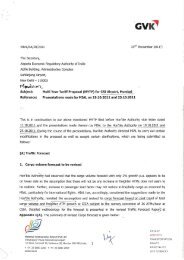Annexure II - AERA
Annexure II - AERA
Annexure II - AERA
You also want an ePaper? Increase the reach of your titles
YUMPU automatically turns print PDFs into web optimized ePapers that Google loves.
NERA<br />
Economic Consultinq<br />
airport), Between these two extremes, also an intermediate approach (i.e, an hybrid till) may<br />
be followed. Appendix A provides a description of these three different regulatory till<br />
approaches.<br />
The fact that ICAO explicitly mentions different approaches to be adopted by regulators in tariff<br />
determinations, and that these approaches range from a single till to a dual till, confirms that<br />
<strong>AERA</strong>'s interpretation ofICAO policies - according to which the single till is the only<br />
regulatory till which comply with ICAO guidelines - is not correct.<br />
We also believe that , in few cases, <strong>AERA</strong>'s conclusions may represent a twist ofICAO<br />
principles. For example, in order to demonstrate that "it is clear from harmonium construction<br />
that ICAO guidelines indicate that non aeronautical revenues should be either used for funding<br />
investment need (capex) of aeronautical activities or to defray aeronautical charges", <strong>AERA</strong><br />
mentions the following extracts from ICAO's documentsr'<br />
" When determining contributions from non aeronautical revenues, high priority should<br />
be given to the investment needs ofairports [...]. It may be appropriate for airports to<br />
retain non aeronautical revenues rather than lise such revenues to defray charges.<br />
However, there is no requirement for airport to do so and, in appropriate circumstances,<br />
there may be solid grounds for charges to be lower, consistent with Doc 9082,9<br />
It is interesting noting that <strong>AERA</strong> adds emphasis to the last sentence ("However, there is no<br />
requirement for airport to do so and, in appropriate circumstances, there may be solid grounds<br />
for charges to be lower, consistent with Doc 9082'). Complete reading of the entire paragraph<br />
(and not of the single sentence) would indicate that, in general (i.e, in most cases), ICAO<br />
policies specifically state that it may be appropriate for airports to retain non-aeronautical<br />
revenues, rather than to use such revenues to defray charges. However, in some specific<br />
circumstances (i.e. in some cases), ICAO recognises that it may be appropriate for airports to<br />
deem a full or partial use of non-aeronautical revenues to defray aeronautical charges as<br />
appropriate or necessary to increase their competitiveness. Therefore, emphasis added by <strong>AERA</strong><br />
on the second sentence instead of the first one unavoidably leads reader to misinterpretations of<br />
ICAO principles.<br />
In the past, the issue on which regulatory till approach should be regarded as consistent with<br />
international practice and, in particular, with ICAO policies and guidelines, has been discussed<br />
for a long time .<br />
<strong>AERA</strong> (20 <strong>II</strong>), Order No, 13120I0-11, In the Matter ofRegutntory Philosophy and Approach In Economic Reguletton of<br />
Airports Operators, par. 5.23.<br />
ICAO (2006), Airport Economics Manual (Doc. 9562/2) , page 4-15.<br />
<strong>Annexure</strong> <strong>II</strong>-B<br />
CP No. 9/2013-14/T-12023(14)/1/2012- Tariff- Vol - <strong>II</strong>I <strong>Annexure</strong> <strong>II</strong>-B Page 21 of 51<br />
4
















